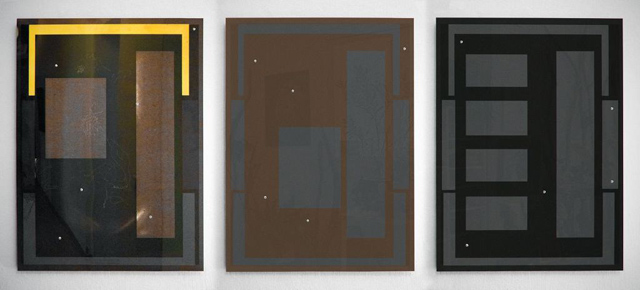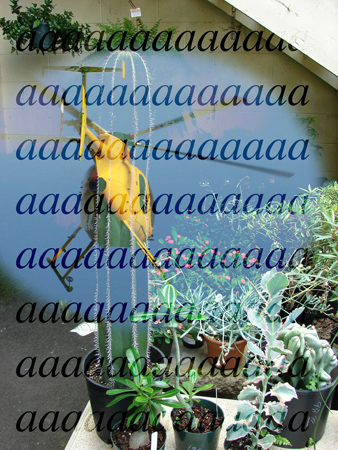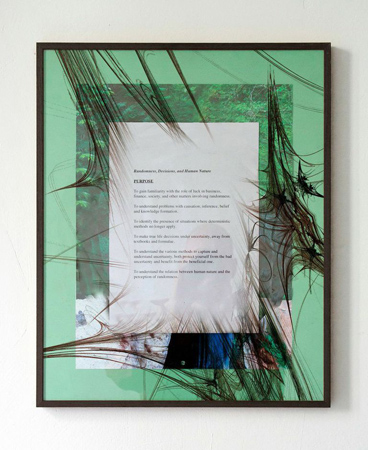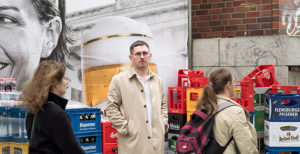“We got there (late)”, says one of the alt-text boxes in Harm van den Dorpel’s ‘Deeptis.su’. It’s a durational online work running over an eerily upbeat and repetitive soundtrack, as disjointed images develop and diffuse across a slideshow of equally contrasting and transient wallpapers. There’s a sketch of a Victorian Lady stood next to a pair of computer speakers, the words “some things that work in one decade” emerging over gloomy-hued brushstrokes before slowly vanishing to white: “just don’t work in the next”. Gestural streaks of complementary colours, a lorem ipsum site template and evaporating beads of water grow out of, and melt into each other as these small fragments of text, thoughts, occur randomly across a browser window: “it was still soaked with information”.
This is one of the most recent works by the Berlin-based artist, whose practice has changed, shifted and evolved over his early Club Internet days, to the negative connections in the research, influence and process presentations of ‘Dissociations’, and his newest curatorial project ‘Deli Near Info’. The latter is something van den Dorpel calls an algorithmic studio with a social dimension, open to anyone, and made in response to the unnaturally streamlined nature of contemporary social media. “I made that system because I couldn’t work with the existing blogging software,” he tells me via video across cities; van den Dorpel at his new studio in Berlin’s Prenzlauer Berg, myself at my desk in London. “Existing systems are completely linear. There’s always a new one added but there are never really connections between the posts in time”.

As an artist born in ‘81, of a computer science background and living through the shift from the self-initiated, self-sustained and largely unnoticed ‘net art’ days of the web, to the ubiquitous Facebook, Twitter and Tumblr-driven online art world of today, van den Dorpel maintains an ambivalent position in relation to contemporary practices. He’s one who’s achieved a measure of success since starting out buying “corporate-sounding” domain names and turning websites into art spaces, now become absorbed into the greater gallery system and losing his claim to the Creative Web he in some ways had a hand in building. But, far from becoming disconnected from his roots as an artist interested in artificial intelligence, it’s in the rubble of this very collapse between the lawless frontier-past of an internet without infrastructure and its current corporatised state, that van den Dorpel’s work actually rests. Despite his assertion that “internet art is dead”, he’s taken to still producing online, while leaving his digital exhibitions undocumented and material object-art destroyed. Because it’s an amalgamation of ideas, images and processes that make up these material/immaterial hybrids into such beautiful and ultimately human work.
“I’ve always been very interested in how thought is organised and how people learn and if you could even simulate or represent this”, van den Dorpel says about the conceptual framework of a practice that seems to flatten the hierarchy of time into an accumulation of instances, taken from the past and reiterated in the always-moving present. “The works themselves, they have this organisational structure, almost like an algorithmic organisation of how you group things in your mind and then that is also repeated in how the pages are laid,” he adds about the internal logic of a piece like ‘Deli Near Info’: “the work is happening on that page.”
‘deeptiss.u’ is a durational piece that you have to sit through, was that a conscious decision?
HvdD: Yeah. The work is somehow generated on 83 or so dissociations. It’s a generative piece and, if you’re talking about a conclusion of online activity, in hindsight that work is one. It also marks the end of ‘Dissociations’ when I moved on to ‘delinear.info’. I’d maybe call it the conclusion of that.
The role of text in your work, why are you focusing on that more now?
HvdD: I never really dared to write because English is not my native language but why I’m writing now is because it’s kind of powerful, or it’s free, combining these. I think I started the writing when I was making captions for art pieces, or descriptions of them, and then I found I only understood the art piece after I wrote the caption, and then the captions became more elaborate.
When I read the text, I had my own interpretation of the work. I absorbed some fragments while dismissing others to construct, or apply to my own narrative of reason.
HvdD: Filtering.
Is that something you’re thinking about?
HvdD: I wanted to make something that has complexity. Where you don’t understand it all but it’s still functional in your reading of it, which is also my conviction that there’s no overview anymore, there’s no index page. There’s not a page on YouTube where you can go ‘these are the pages on YouTube’. The rhizomatic structure is the reality now and I tried to make this a way to navigate it.

Do you mourn that lack of an index page, and also do you think that’s strictly true? The hegemony of mass media seems stronger than ever.
HvdD: There are systems that are taxonomically organised, like classes, or categories, or stores, and they’re always based on text grouping, like, ‘this is that or that is that’ based on years, or other metadata. I tried to make systems that are based on intuition; where you can’t even know why something belongs to something else, you just have to associate.
I think language, text, is still prevalent online; it’s still dominating grouping systems. And taxonomies are always a mess. If you go and see a tag cloud on a website, it’s always ridiculous. The category errors are very funny. So ‘Deli Near Info’ is based on a graph database, which has weighted factors, of ‘this is more associated than that’, which is also used on Twitter with recommending friends or ‘follows’. I like to think about those organisational structures that have emergent behaviours.
Are you generating your own kind of artificial intelligence, in some way, reflecting the human experience in the software and your processes?
HvdD: Not so much the experience but more the development of the mind and thinking of how information is embedded in a composition but also in time: ‘what other movement does this associate with?’ Those are questions that I like.
When you say social media is just for entertainment what do you mean?
HvdD: I think a lot of internet activity in social media, it’s just a constant stream of something new, and new, and there’s no conclusion; there are no crossover links. In my practice, when I look back at something that I made in the past, and compare it with more current activity, things start to make more sense.
I wanted to make a system in which combining works is actually the work itself. There’s a curatorial element to my own practice, so sometimes I just make specimen that I feed into the system and see how it behaves in relation to other nodes, other text, or other images and all the cross sections in time. Old things and new things can be combined, and over time it grows and the connections become more interesting. At least that’s what I hope. You don’t really get that in social media, which is more just an endless stream. You add something on top and you’re supposed to forget what’s on the bottom.
It’s interesting that you think that way because it comes across as a sort of duality, which I suppose is a reflection of your practice working across the immaterial and material, and also the ephemeral and the permanent. You yourself destroy your objects and primarily archive online. What’s the difference between doing that, and allowing things to be forgotten in a stream?
HvdD: The important thing for me is that the database grows, the archive grows, in order to understand better what it means to make a piece of art. Then I gain insights into my own thinking more and discover unconscious decisions. This is the ultimate goal.
But the art pieces are often destroyed, or they never existed in the first place, because they’re renderings. It’s still essential to make physical work though, because software doesn’t give you the problems that materials have. These problems, these restrictions, are good.
You said before that ‘internet art is dead’ and you’re one of the few artists working in that early millennial era that is still producing work online. What about it is ‘dead’ and what was the goal in the first place?
HvdD: There was not necessarily a goal or agenda, it’s just that it was possible, it was also the only venue we had access to, it was free and it was fun. Also, if you were making something for online, you actually had to do it all yourself and now people are more like using existing boxes to put something in, like social media, which is totally fine. I’m just a very technological person. I like programming and I want to have control.
It sounds like your issue with social media is more political than you’ve been making out.
HvdD: It didn’t start with a political agenda, but I find it quite dangerous that these huge infrastructures of social media have no other agenda than to make money. It’s like hyper-privatisation and I don’t know where it’s going. My work is reacting to that, or opposing it, or trying to give some alternative networks.
Obviously, I’ve only limited resources to make my own startup [laughs], but I try to make some system that somehow works. I don’t even know if other people will use it, maybe that’s not even the goal. It just exists like other things.
As an artist coming from those early days where the infrastructure was still not available for art online, how do you reconcile the way you want to make work and the way you have to in a gallery context?
HvdD: It really exists in this hybrid. I said once in an interview that the physical objects, which the collector eventually buys, that’s their problem [laughs]. I call it the debris; the things that fall off. And, of course I like to sell, but I also like the material object. I could just simulate everything with software but I think I need this materiality to make the thing.

So it’s an adaptive approach for survival as an artist but you also just like the process.
HvdD: I have this ongoing investigation into the materiality of printed stuff. The collages on that page, again as an example, especially this one [sends link to ‘Reverse Engineered Consent’ (2014)], the one on the left is real and its made of printed textures from a stock footage material collection which you can use for 3D software. I printed the materials on it but when you come close you can see that it’s the actual real material, but you can also see it’s still a print. It’s like a kind of unreal collapse in a way, and then in the print, in the backside I scratched the image, and the resolution of the print makes you really aware of it. It’s almost like a screen and it also has no frame. **
Harm van den Dorpel is a Berlin-based artist taking part in the In Its Image group exhibition at New York’s American Medium, running July 19 to August 24, 2014.
Header image: Harm van den Dorpel, ‘History States’ (2012). Courtesy the artist and Wilkinson Gallery, London

















